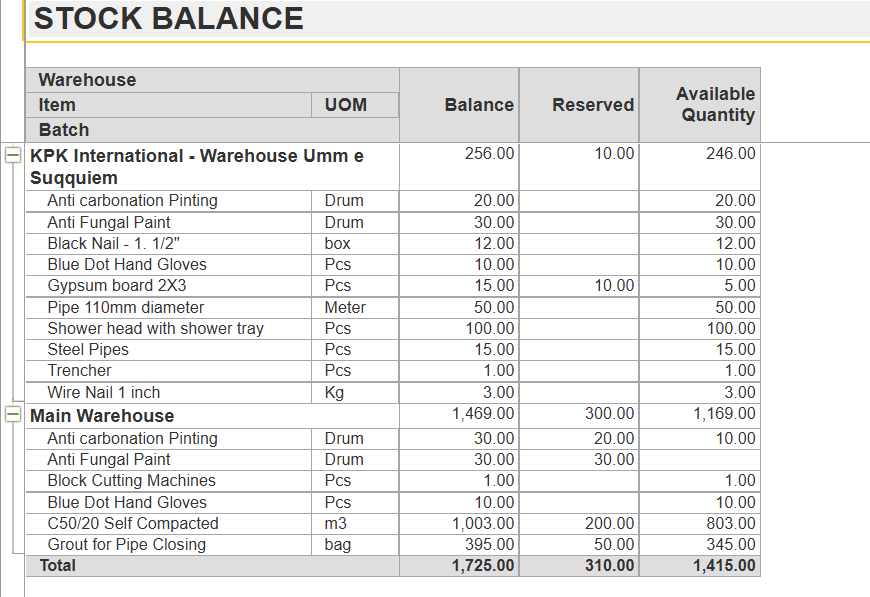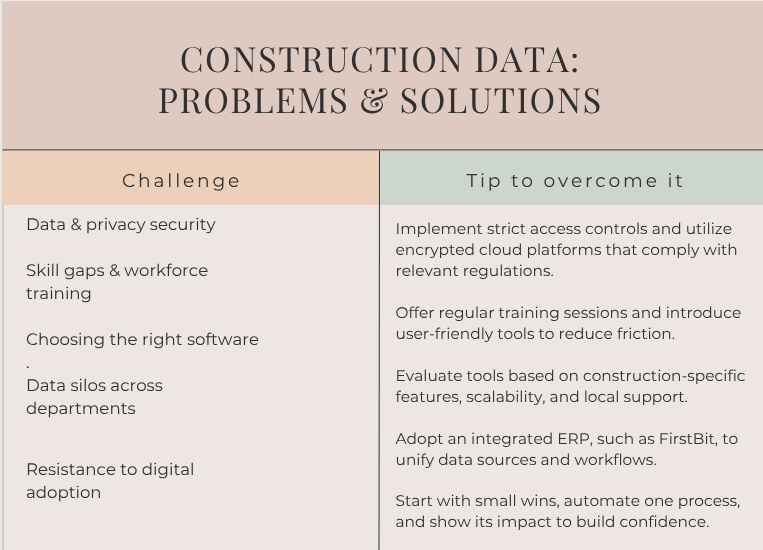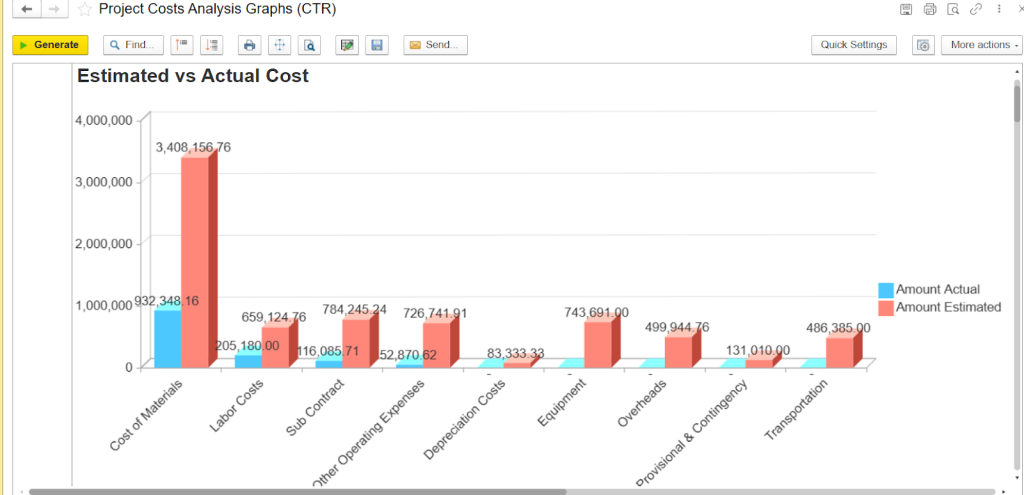The construction industry has historically been slow to adopt digital tools compared to sectors like manufacturing or finance. For years, project decisions relied heavily on manual processes, isolated spreadsheets, and instinct-driven planning. But as margins tighten and projects grow in complexity, that’s no longer sustainable.
Today, data is emerging as the backbone of the modern construction industry, from early-stage design and cost estimation to procurement, scheduling, and quality control. It’s not just about collecting information, but about turning that information into actionable insights that improve timelines, budgets, and risk management.
According to KPMG’s 2023 Global Construction Survey, 81% of engineering and construction firms now use mobile platforms, 43% have implemented robotic process automation (RPA), and 37% are deploying AI tools for analytics or project control[?].
This rapid uptake signals a fundamental shift in how the industry approaches technology. Contractors and developers who embrace this change aren’t just collecting data; they’re using it to drive better decisions, reduce rework, and stay competitive in a volatile market.
The Role of Big Data in Construction
Construction today is no longer managed through paperwork, disconnected reports, or gut feeling. Projects are larger, timelines are tighter, and margins are thinner, leaving no room for guesswork.
Data has become the foundation for how construction firms plan, execute, and control projects. Whether it’s tracking material usage, monitoring labor hours, forecasting costs, or identifying delays, every major decision now depends on timely, reliable data.
It’s not just about collecting information; it’s about making that information actionable. When used correctly, data helps:
-
Spot inefficiencies before they escalate
-
Improve coordination between departments and subcontractors
-
Enhance safety compliance and reporting
-
Keep schedules and budgets under control
Firms that invest in real-time data access and system integration are the ones staying ahead, making faster decisions, reducing waste, and delivering more predictable outcomes.
Key Trends Driving the Data Revolution
As data becomes a central asset in construction, several trends are accelerating its adoption across the industry.
Big Data and Analytics in Construction
Construction projects generate large volumes of data: site reports, sensor feeds, labor hours, materials logs, and financial records. Big data analytics makes it possible to extract actionable insights from this growing pool of information:
-
Forecast risks like cost overruns or weather delays
-
Identify productivity gaps across trades or subcontractors
-
Optimize procurement timing and quantities based on usage trends
Used correctly, big data transforms fragmented data into a continuous loop of process improvement.
Internet of Things (IoT) and Smart Construction Sites
Smart sites are powered by connected devices such as wearables, RFID tags, and sensors that collect real-time data on site safety, equipment usage, and material conditions.
These devices help teams anticipate delays and mitigate risks. For example:
-
Monitoring concrete curing temperatures to prevent quality issues
-
Tracking worker location to enforce safety zones
-
Identifying idle machinery or unexpected fuel usage
IoT enables a shift from reactive problem-solving to preventive management.
Rise of Cloud-Based Construction Management Tools
The shift from desktop-based systems and manual spreadsheets to cloud-based tools is one of the most transformative trends in modern construction. These platforms enable stakeholders, engineers, estimators, procurement teams, and site supervisors to access up-to-date project data from anywhere, at any time. This flexibility is crucial for multi-site projects and remote collaboration.
Cloud-based solutions streamline everything from scheduling and approvals to file storage and team communication. They help reduce delays caused by outdated information or misaligned documentation, a common issue in traditional workflows.
According to a 2025 industry report, 60% of construction firms now use cloud-based platforms for project management and collaboration[?].
FirstBit Construction ERP offers a cloud-native platform that connects all departments. Estimators can upload takeoffs and BOQs, finance teams can access real-time budget updates, and site engineers can monitor task progress—all in one centralized workspace. This level of integration minimizes bottlenecks, improves traceability, and ensures that teams always work with the most current information.
Integration of ERP Systems
As construction projects grow in scale and complexity, relying on disconnected systems creates inefficiencies. An estimator may calculate quantities in Excel, while the procurement team might use separate tools to place orders, and finance may track costs on an entirely different platform. This lack of integration increases the risk of duplication, delays, and miscommunication.
Modern ERP (Enterprise Resource Planning) systems address this by unifying core business functions such as estimating, scheduling, payroll, procurement, and reporting into a single software environment. When everything runs through the same platform, data flows seamlessly across departments. Estimations become POs, labor hours become payroll entries, and budget updates reflect in real time.
FirstBit ERP offers a framework tailored especially for the construction sector. From project initiation to handover, users can:
-
Import takeoffs and directly link them to procurement workflows
-
Monitor project costs against estimates without needing manual reconciliation
-
Track labor productivity and site expenses with built-in financial tools
This ensures that field and finance teams operate on the same data, reducing rework, saving time, and boosting decision-making accuracy.
No more lost data
Protect what matters with cloud backups
Request a demo
Top Benefits of Utilizing Data in Construction
As construction projects become more complex, the ability to gather, process, and act on real-time data is no longer a luxury—it’s a necessity. From reducing costly delays to improving on-site safety, data-backed decision-making empowers construction teams to operate more efficiently and competitively. Below are some of the most impactful benefits companies are already experiencing.
Improved Project Efficiency and Productivity
Data analytics streamlines workflows by enabling proactive planning and real-time performance monitoring. Managers can identify delays early, adjust schedules, and improve labor allocation. This directly impacts project timelines and reduces idle time.
Enhanced Safety and Risk Management
By analyzing safety incident data, environmental conditions, and equipment logs, companies can identify risks early. Predictive insights allow safety teams to implement controls before accidents occur, leading to improved site safety and fewer claims.
Cost Reduction and Budget Optimization
With real-time tracking of labor, materials, and equipment, financial leakage is minimized. Data from past projects supports more accurate budgeting and helps prevent overordering, underutilization, and scope creep.
Better Decision-Making Across Teams
When data is centralized and accessible, decision-making becomes faster and more aligned. Site managers, engineers, and procurement teams can coordinate based on the same facts. This reduces miscommunication, speeds up approvals, and drives better collaboration across functions.
Top Challenges and Tips to Overcome Them
Despite its advantages, adopting a data-first approach isn’t without its hurdles. Construction firms often face technical, operational, and cultural roadblocks when integrating digital tools into their workflows. Understanding these challenges and having a clear plan to address them can help businesses avoid setbacks and maximize ROI from their tech investments.
1. Data and Privacy Security
The increasing reliance on digital tools in construction has raised serious concerns about data security. Sensitive information—like financial reports, client details, and project blueprints—is vulnerable to cyberattacks or unintentional leaks, especially when stored in unprotected systems or shared across unsecured channels.
Tips:
-
Use industry software with enterprise-grade encryption and secure cloud storage.
-
Set role-based access controls to prevent unauthorized data exposure.
-
Educate staff about phishing risks and security best practices.
-
Perform regular data backups and audits to ensure integrity.
2. Skill Gaps and Workforce Training
Many construction firms struggle to adopt data-driven tools due to limited technical know-how among their staff. Even if the tools are available, poor onboarding and a lack of training reduce usage and ROI, especially for mid-sized or growing firms.
Tips:
-
Start with tools that have a user-friendly interface and a low learning curve.
-
Assign internal “software champions” to help train others on new tools.
-
Offer hands-on sessions during onboarding, not just user manuals.
-
Encourage continuous learning through webinars or vendor-led tutorials.
3. Choosing the Right Software
The abundance of construction tools available makes it hard to choose one that aligns with both business goals and team capabilities. Many solutions either overpromise or are too generic to meet the demands of real-world construction workflows.
This is where purpose-built solutions like FirstBit Construction ERP can make a measurable difference. Designed for construction-specific challenges, FirstBit integrates cost control, estimation, procurement, accounting, and project planning into one platform. Its localized compliance features and intuitive design also reduce the burden of long training cycles.
Tips:
-
Choose software tailored for construction workflows, not generic ERP systems.
-
Look for modular solutions that allow you to scale as needed.
-
Test demo versions with your actual data or team before purchasing.
-
Prioritize local support and onboarding services when available.
4. Resistance to Change
Adopting data-driven systems often meets resistance from field teams or leadership unfamiliar with technology. This cultural barrier can prevent even the most effective tools from being properly implemented.
Tips:
-
Start small, pilot the software on one project before scaling organization-wide.
-
Involve field teams in tool selection to increase buy-in.
-
Show the ROI of using data tools through measurable project wins.
-
Promote a culture where innovation is rewarded, not resisted.
Transform your business and lead the industry
Request a demo
Future Outlook: What’s Next for Construction Data?
As construction firms continue to realize the strategic value of data, the next decade will bring more than just better dashboards. It will reshape how projects are planned, managed, and delivered. From the early design stages to long after project completion, data will no longer be a supporting tool; it will be central to every decision and every phase of the construction lifecycle.
How Data Will Shape the Next Decade in Construction
The construction industry is moving toward a predictive, real-time approach, where decisions are driven by actual conditions on-site rather than static timelines. As data quality and accessibility improve, project stakeholders will shift from reactive to proactive decision-making.
Instead of using data to look backward and analyze what went wrong, teams will increasingly use it to anticipate what’s likely to happen next and take action accordingly. This shift will influence how companies allocate resources, manage risks, and stay on schedule.
Adoption of Advanced Technologies
Technologies like artificial intelligence, machine learning, and digital twins will move from experimental to essential.
-
AI will play a stronger role in automating daily tasks such as progress tracking, compliance checks, and resource optimization.
-
Machine Learning will continually learn from current and past project data to fine-tune processes without manual recalibration.
-
Digital twins will enable teams to test “what if” scenarios before implementing real-world changes, dramatically reducing error margins and project delays.
This convergence of analytics with automation will set new standards for construction efficiency.
Enhanced Collaboration and Data Sharing
As construction becomes more complex and collaborative, the ability to share accurate, up-to-date data across teams will be critical. Siloed systems will give way to unified platforms that provide real-time visibility across functions—from finance to field operations.
FirstBit Construction ERP supports this shift by offering a centralized data environment that bridges departments, contractors, and clients. Whether it's financial tracking, resource planning, or project execution, integrated platforms like FirstBit help ensure that every stakeholder is aligned and working from the same set of facts.
Conclusion
Data is no longer optional; it’s foundational. The construction companies that act now to build a scalable, secure, and flexible data strategy will outperform those that hesitate. From risk reduction and smarter scheduling to AI-driven insights and seamless collaboration, the future of construction is insight-led and technology-powered.
ERP that saves your money
Adopt FirstBit ERP to cut costs, boost ROI, and effectively plan future cash flows
Request a demo
FAQ
How does data improve construction project management?
How does data impact safety on construction sites?
What are the most promising trends in data usage for construction?
What are some successful examples of data usage in construction?
How can data contribute to sustainable construction practices?

Umme Aimon Shabbir
Editor at First Bit

See FirstBit ERP solutions in action
Discover how our system solves the unique challenges of contractors in a personalized demo.
After the demo you will get a quotation for your company.
After the demo you will get a quotation for your company.














